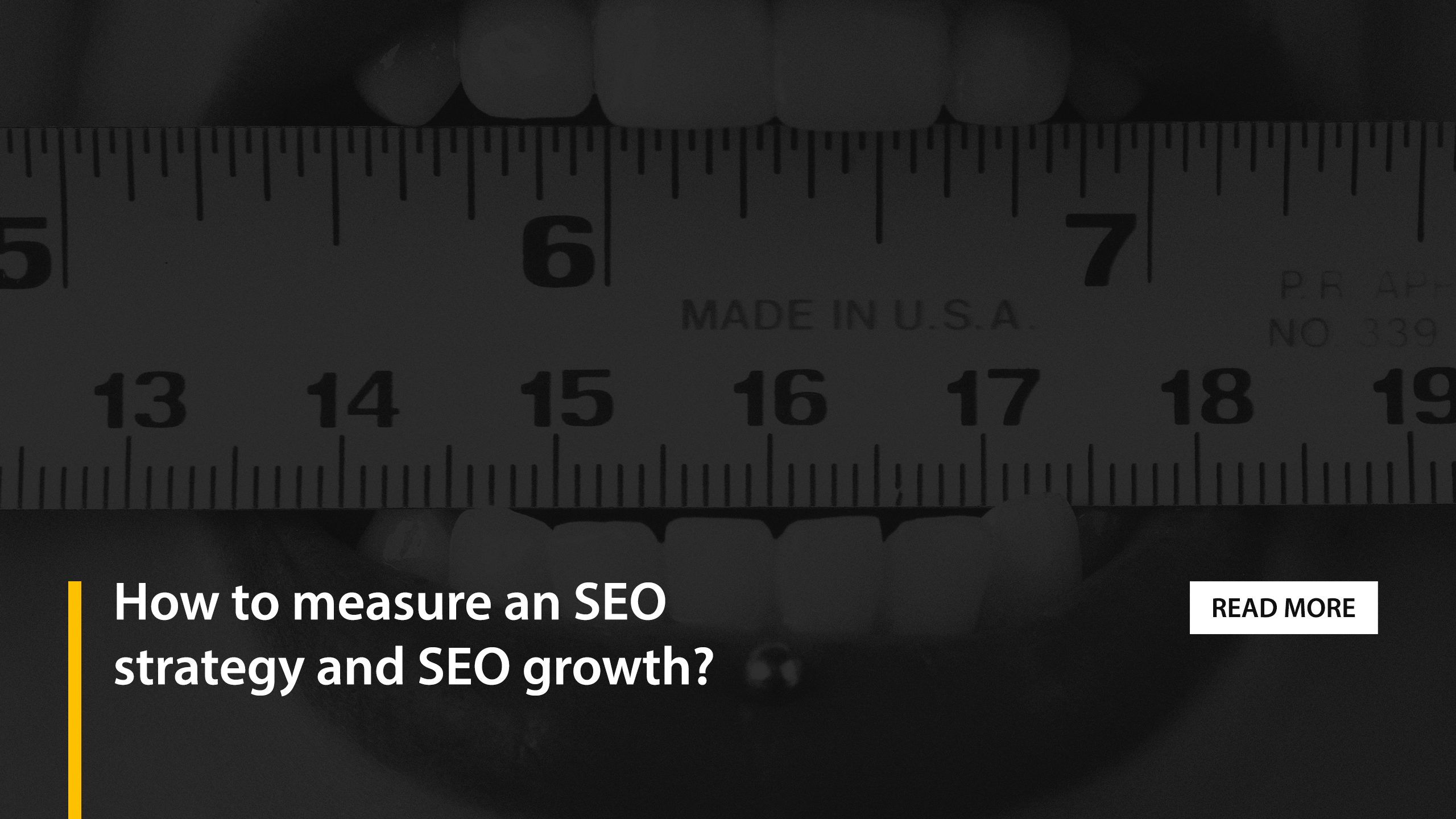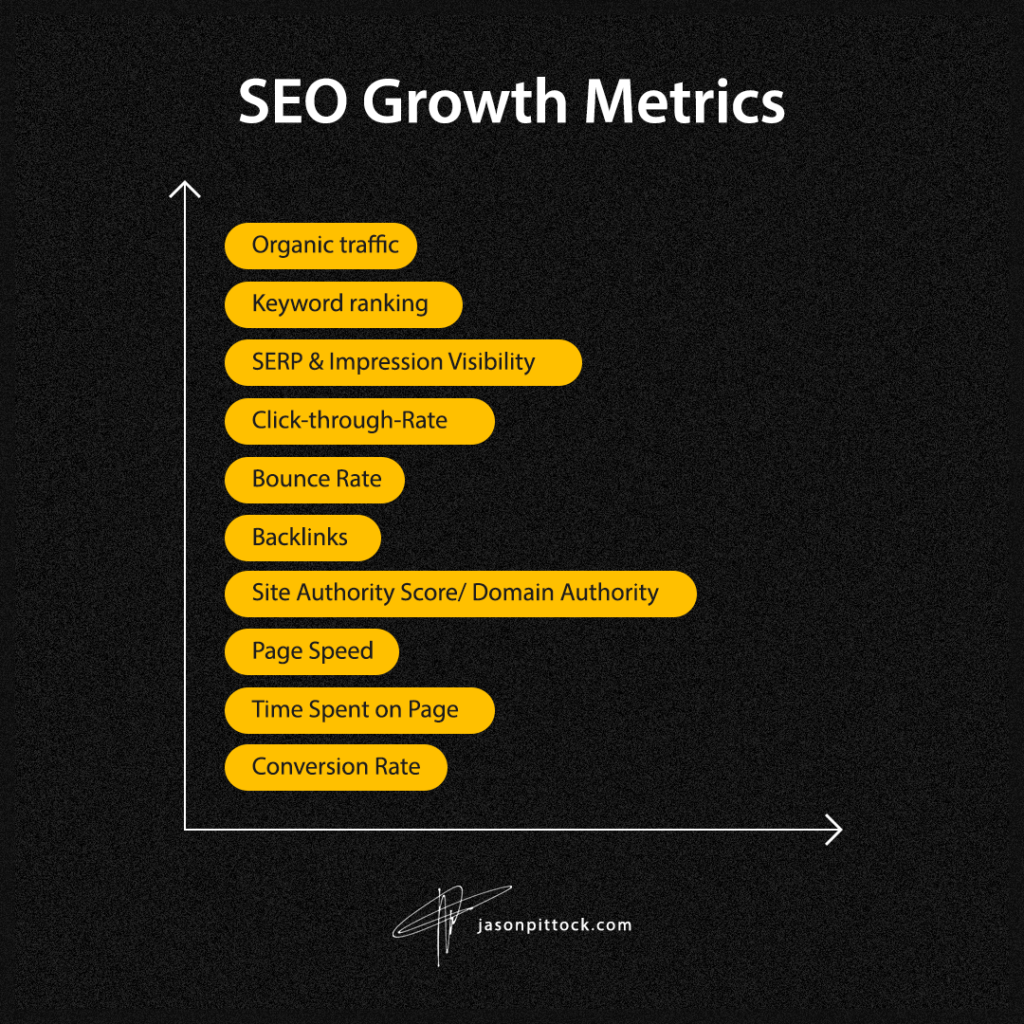
Search Engine Optimization is the process of improving the visibility and quality of a website so that it may attract more visitors from search engines, through organic or unpaid search results. The goal of SEO is to improve the visibility, user experience, and quality of a website so that it may attract and retain more visitors from search engines.
Given that SEO is on everyone's lips, you'd think everyone out there already has at least a basic SEO strategy in place. Yet, as it seems, more than 70% of small businesses don't use SEO to drive growth.
If you're among them (and you've decided to jump on the SEO wagon) or if you just need to rethink your approach to SEO, this article is for you.
Before rushing out and buying a bunch of backlinks or redoing your website to be “SEO friendly” you need to grasp how to successfully measure and quantify the impact of SEO.
In essence, SEO growth can be measured through a series of specific KPIs. The most common ones include:

Organic traffic is, simply put, the number of organic visitors coming to your website from search engines. You can measure this KPI by looking at the number of unique visitors coming to your site from organic searches.
To do so, you'll need to set up Google Analytics and Google Search Console and connect it to your website. Once you've done that, go to Acquisition > All Traffic > Channels and in the case of Google Search Console, go to Performance and review a period of time that fits your analysis. There, you'll be able to see the number of organic visitors coming to your website and also the number of impressions.
Keep in mind that, depending on your business and website, the amount of organic traffic can vary.
If you're just starting out, don't worry if your organic traffic numbers are low. The important thing is to track your progress and see how those numbers change over time as you implement your SEO strategy.
Keyword ranking is defined as the position that your website content occupies in the SERPs (Search Engine Results Pages) for a given keyword.
For example, let's say you rank #3 for the keyword "SEO tools." That means that, when someone types that keyword into Google search engine and your website content appears in the results, it will appear as the third website in the organic search results. The content on this page has been optimized for “SEO tools” and Google recognizes this, therefore it positions your content in the search engine results.
To measure your keyword ranking, you can use a number of different tools, including Google Search Console, Moz's Keyword Explorer, and SEMRush.
Once you have a list of the keywords you want to track, simply plug them into the tool of your choice and see where your website ranks. As with organic traffic,
SERP visibility is a method of measuring how often your website appears in the SERPs for a given keyword. In the Google Search Console, this is called “impressions”.
To calculate your SERP visibility ratio, simply take the number of impressions your website receives for a given keyword and divide it by the total number of searches for that keyword.
For example, let's say your website appears in the SERPs for a given keyword 100 times out of 1,000 searches. Your SERP visibility would be 10%.
You can measure your SERP visibility using Google Search Console. To do so, go to Google Search Console and click on Search Results > performance. There, you'll see the number of impressions and clicks your website has received for each keyword.
The click-through rate is the percentage of people who click on your website after seeing it in the SERPs.
To calculate your CTR, simply take the number of organic clicks your website receives for a given keyword and divide it by the number of impressions.
For example, if your website appears in the SERPs for a given keyword 100 times and receives 10 clicks, your CTR would be 10%.
You can measure your CTR using Google Search Console. To do so, go to Google Search Console and click on Search Results. There, you'll see the number of impressions and clicks your website has received for each keyword.
Bounce rate is the percentage of people who leave your website after viewing just one page.
A high bounce rate is generally considered to be a bad thing, as it indicates that people are leaving your site without taking any desired action (such as taking a specific conversion action and engaging further with your content).
You can measure your bounce rate using Google Analytics. To do so, go to Acquisition > All Traffic > Channels. There, you'll see the bounce rate for each channel.
Keep in mind that a good bounce rate will vary depending on your business and website. However, as a general rule of thumb, anything under 40% is considered to be good.
Backlinks are links from other websites to your website. Google takes them as "votes" for your own website's health, relevance, and quality.
Generally speaking, the more backlinks you have, the better. That's because backlinks are one of the main ranking factors in Google's algorithm.
To measure your backlinks, you can use a number of different tools, including Moz's Open Site Explorer and Semrush.
One important note to make here is that there’s a massive difference between backlinks from link farms (or spam links) and truly good backlinks. Buying backlinks might seem quick and smart, and for a while, it may even drive your traffic up. But, like in gambling, the house always wins – and Google too. Sooner or later, they will figure out there’s something odd going on with your backlink profile, and they will penalize you for it.
Site authority is a non-search engine metric of how strong your website is in the eyes of Google or other search engines. This mysterious measurement is generally calculated using a number of factors, including the age of your domain, the number of backlinks you have, the quality of those backlinks and the contextual authority of the content on your website.
Site structure and content legibility are also key determining factors in this algorithm.
Generally speaking, the higher your site authority, the easier and quicker it will be for you to rank in the SERPs.
To measure your site authority, you can use a number of different tools, including Moz's Open Site Explorer and Domain Overview by Semrush.
Page speed is the amount of time it takes for your website to load. Google has stated that page speed is a ranking factor, so it's important to make sure your website loads quickly.
To measure your page speed, you can use Google's PageSpeed Insights tool. Simply enter your URL and Google will give you a report on your page speed.
Time spent on a page is the amount of time people spend on your website before leaving.
Generally speaking, the longer people spend on your site, the better. That's because it indicates that they find your content relevant and engaging.
You can measure your time spent on a page using Google Analytics. To do so, go to Behavior > Site Content > All Pages. There, you'll see the average time spent on each page.
Keep in mind that a good time spent on a page will vary depending on your business and website. However, as a general rule of thumb, anything over 2 minutes is considered to be good. However, this depends on the type of content you have too -- such as whether you're more focused on long-form content or short-form content, for example.
The conversion rate is the percentage of people who take the desired action on your website.
For example, if you're an eCommerce store, your desired action might be making a purchase. If you're a B2B company, your desired action might be filling out a form or subscribing to your email list.
You can measure your conversion rate using Google Analytics. To do so, go to Conversions > Goals > Overview. There, you'll see your conversion rate for each goal you've set up.
Keep in mind that a good conversion rate will vary depending on your business and website. Generally, though, a good conversion rate would be anything over 1-2%.
There's a lot that goes into SEO, and it can be difficult to keep track of all the different ranking factors. However, by keeping an eye on the most important ones, you can ensure that your website is optimized for search engines and that you have a good chance of ranking in the SERPs with organic visibility.
I often say that SEO strategies are dictated by business strategy, not the other way around. Often businesses can be found chasing after all the SEO possibilities and losing focus. This leads to frustration, and loss of time and resources.
It is very important to note that all these SEO growth metrics mean nothing if your strategy isn't focused on driving real business growth. Here are some tips on how to build a measurable SEO strategy without getting uber-lost in the weeds:
This will ensure that the SEO goals are in line with the company's overall objectives and that it supports your business' real growth. Traffic, time spent on site, and even CTRs are great -- but if they don't drive more cash into your bank accounts, or more revenue opportunity, you have an issue (and most often, this problem revolves around the fact that SEO isn't aligned with the other business verticals.)
Choose an SEO metric you know you can commit to, and go all in. The key to unlocking SEO growth is by developing the trait of consistency. To many business test strategies for 1-2 months and give after not seeing results. Then they try the next SEO metric and it doesn’t work, and this goes on and on.
SEO is "day in and day out", doing one thing well, consistently.
Above all, it's important to own the SEO Growth metric you choose, and understand everything that goes into it, including attributing the success of the efforts employed for this strategy.
SEO metrics measurements should be like clockwork. They should be regular and intentional, and you should never go more than a month or two without looking at them. You can use Google Analytics, Search Console, and a host of other tools to measure your SEO metrics.
With all things, develop the skill of perspective, SEO is not a profit and loss.
It's important to remember that SEO should never be looked at in a vacuum. Instead, you should always measure it alongside:
Following all these metrics (and doing so correctly) will give you a more holistic view of your marketing efforts and how they're performing. Simply put, you need to take a step back and look at the big picture every once in a while.
At the end of the day, it's important to remember that data is amazing, but if you look at data through a very narrow lens, you're missing the point on how SEO should be driving your business forward. Take your SEO metrics with a pinch of salt, a lot of common sense, and a clear understanding of where you are and where you want to go as a business -- this will help you make SEO work for your business, instead of chaining down your business to SEO.